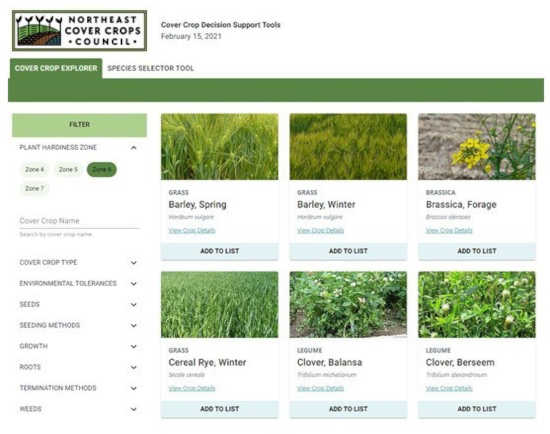By Zachary Larson
This new web-based app allows you to compare cover crops or select species based on farm goals.
The Northeast Cover Crops Council recently unveiled its Cover Crop Decision Support Tool. The web-based app allows you to explore the function and characteristics of cover crop species suited to the northeast and provides recommendations for cover crops based on user-defined inputs.
The tool is one of the first projects of the Northeast Cover Crops Council, an organization formed in 2016 to support and promote the adoption of cover crops and foster the exchange of information and outcome-based research. The council is governed by a board representing universities, agri-business and farmers from Maine through Maryland and Delaware.
The tool was developed through the collaboration of experts throughout the Northeast and represents their collective knowledge and experience of cover crops. Collaborators evaluated each cover crop characteristic in the dataset via discussions in over 70 teleconferences in 2019 and 2020. Collaborators from Penn State included Sjored Duiker, Dave Wilson and Zach Larson. Cover crop data for the tool was adapted from the Midwest Cover Crops Council species selector tool and was reviewed, modified, and expanded to match the Northeast’s USDA plant hardiness zones and cropping systems. Additional data sources adapted for this tool include the USDA PLANTS database and a seeding rate calculator developed by USDA-NRCS.

The Northeast Cover Crops Council’s new Decision Support Tool provides information on 38 cover crop species well-suited to our region.
The tool features an explorer, where you can learn about the characteristics and benefits of 38 different cover crop species. A series of filters allow you to narrow the list based on environmental tolerances, growth characteristics, and seeding and termination methods. Information is on plating dates and rates is provided for each species as well as management information specific to each cover crop, including links to outside publications or articles.
The second part of the tool includes a species selector that allows you to pick cover crops that optimize your agronomic goals. Up to three goals can be selected, and 'best fit' species are selected, however, the information can also be used to effectively select for species for cover crop mixes. This tool also includes a side-by-side comparison features to help assess multiple species to determine what best fits your needs.
This tool should be an excellent resource for anyone looking to try new or different cover crops. Knowing that the tool’s information is vetted by experts and is regionally adapted means that recommendations will likely work on your farm. If you are finalizing your rotation for 2021, I encourage you to plan now for fall cover crops and try it out. If you find something new to try, preparing now will help in securing seed and learning about the specifics of the crop and can save a lot of frustration later.
The NECCC tool is a result of a design collaboration between the Agricultural Informatics Lab, the Precision Sustainable Agriculture team, the NECCC, and the USDA. This material is based upon work supported by the Northeast Sustainable Agriculture Research and Education program (subaward # ENE 16-144), a USDA NIFA postdoctoral fellowship (grant # 2016-67012-24711), a NIFA SAS CAP grant (project # NC09873), a NIFA OREI grant (project # MD.W-2015-07406), USDA ARS and NRCS, and Purdue University.
Source : psu.edu